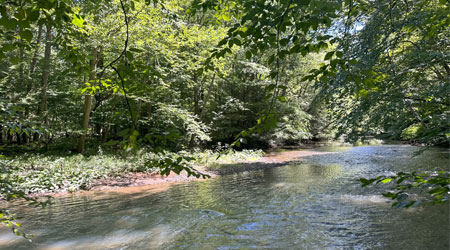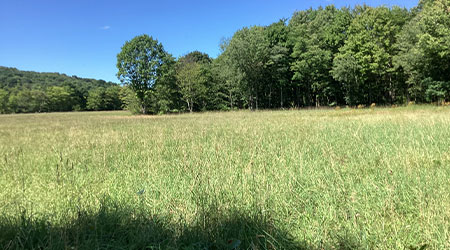One of the property acquisitions creates WPC’s first nature preserve in Cambria County
 PITTSBURGH, PA. – May 20, 2025 – The Western Pennsylvania Conservancy today announced the recent purchase and permanent protection of two properties totaling 507 acres of forested riparian land in Cambria County, most of which are located along the West Branch Susquehanna River.
PITTSBURGH, PA. – May 20, 2025 – The Western Pennsylvania Conservancy today announced the recent purchase and permanent protection of two properties totaling 507 acres of forested riparian land in Cambria County, most of which are located along the West Branch Susquehanna River.
In Susquehanna Township, 364 acres are now open to the public as a new Conservancy-owned nature preserve. Conveniently accessible by the nearby boroughs of Northern Cambria and Cherry Tree, the public can use the area, now known as Basking Hill Nature Reserve, for recreation such as hiking, hunting, fishing and wildlife exploration. The reserve will offer public fishing access, the first in the county along the West Branch, that will always remain freely open to the public.
Protecting this land safeguards a 1.5-mile corridor of the West Branch and conserves 100 acres of forested floodplain, considered to be one of the most intact forested floodplains in the county. The property also consists of a 264-acre upland forest and reclaimed mine areas that will eventually be reforested.
The Basking Hill Nature Reserve also has historical significance, as part of the Kittanning Path, a major east-west Native American travel route, is thought to have crossed over or near the property boundary. It is also the Conservancy’s first nature preserve in Cambria County.
The purchase of the land for this new nature preserve was made possible thanks to the generosity of the family of B.K. Simon, Richard King Mellon Foundation, Hamer Foundation, National Fish and Wildlife Foundation, Hillman Foundation, and private donations from Conservancy members, including gifts from H. Charles and Sandra Lee Romesburg and the estate of Michael F. Butler.
 In nearby Northern Cambria Borough, 98 acres of a 144-acre property that includes approximately three-quarters of a mile of frontage on the West Branch, will soon provide more public access for community residents to the stream for fishing and other recreational opportunities.
In nearby Northern Cambria Borough, 98 acres of a 144-acre property that includes approximately three-quarters of a mile of frontage on the West Branch, will soon provide more public access for community residents to the stream for fishing and other recreational opportunities.
Northern Cambria Borough now owns the property, which will soon be open for public recreation. The remaining 46 acres do not have frontage on the West Branch and have limited public access, thus making future public use unlikely.
If sold, these acres will be subject to a conservation easement that would limit development and protect the land’s forest values in perpetuity.
Conservation of this land was made possible, thanks to grants from the Susquehanna River Basin Commission, National Fish and Wildlife Foundation and U.S. Fish and Wildlife Service, Hamer Foundation and Hillman Foundation, and with funds from private donations from Conservancy members, including a gift from the estate of Michael F. Butler.
The upper West Branch had been heavily impacted by abandoned mine drainage, but the stream has greatly recovered due to significant investments in the watershed, including a treatment facility upstream of the borough. As a result, an 8.5-mile stretch of West Branch in Cambria County is now classified by the Pennsylvania Fish and Boat Commission as a Class A Wild Trout Stream, which supports a population of naturally produced trout of sufficient size and abundance to support a long-term sport fishery. The permanent protection of these properties along this section of the West Branch builds on and helps the public benefit from this restoration investment.
Conservancy Land Protection Manager Matt Marusiak says outdoor enthusiasts, specifically anglers, will appreciate that these forested lands are now freely open to the public.
“Fishing is a premier pastime in our region, and the West Branch Susquehanna in Cambria County is poised to become a destination trout water,” says Marusiak. “So, we’re glad the public will now have access to these forested areas for a variety of recreation opportunities for generations to come.”
For more information about land conservation options, please contact the Conservancy at 724-238-2492 or land@paconserve.org.
###
The views and conclusions contained in this document are those of the authors and should not be interpreted as representing the opinions or policies of the U.S. Government or the National Fish and Wildlife Foundation and its funding sources. Mention of trade names or commercial products does not constitute their endorsement by the U.S. Government, or the National Fish and Wildlife Foundation or its funding sources.
About the Western Pennsylvania Conservancy:
The Western Pennsylvania Conservancy (WPC) enhances the region by protecting and restoring exceptional places. A private nonprofit conservation organization founded in 1932, WPC has helped establish 11 state parks, conserved more than a quarter million acres of natural lands, protected or restored more than 3,000 miles of rivers and streams, and assessed thousands of wildlife species and their habitats. The Conservancy owns and operates Frank Lloyd Wright’s Fallingwater, which is on the UNESCO World Heritage List and symbolizes people living in harmony with nature. In addition, WPC enriches our region’s cities and towns through 130 community gardens and other green spaces and thousands of trees that are planted with the help of more than 7,000 volunteers. The work of the Conservancy is accomplished through the support of more than 10,000 members. For more information, visit WaterLandLife.org or Fallingwater.org.
Media Contact:
Carmen Bray
Senior Director of Communications
412-586-2358.- work
412-608-3617 – cell
